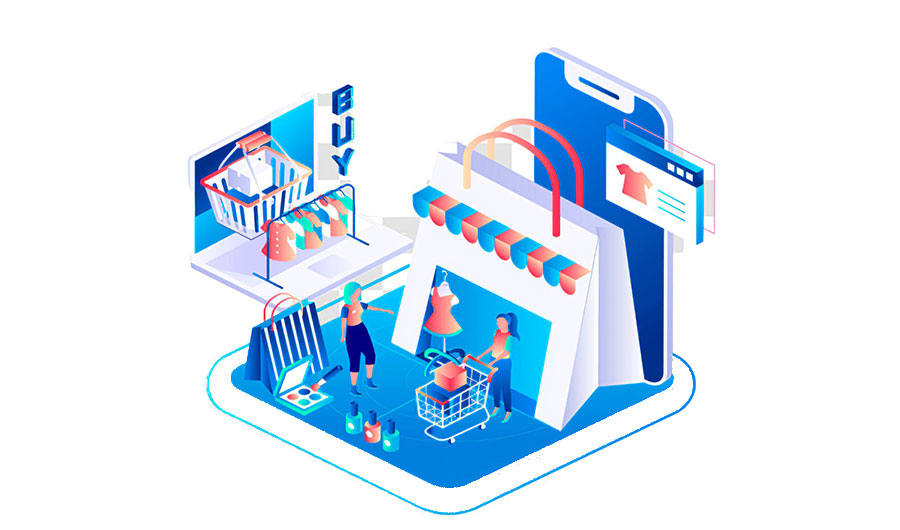
Top 7 eCommerce Trends Shaping the Future in 2024
By 2024, online transactions are projected to constitute a noteworthy 21.2% portion of the entire retail sales scenario, according to the Insider Intelligence Report. This signals a notable transformation in consumer habits, emphasizing the growing significance of digital commerce platforms within the retail domain.
The impact of these forecasts spans a wide range of retail products, channel layouts, technology deployments, and customer experience improvements. To remain relevant in this dynamic market, firms must adapt to changing consumer tastes and behaviors.
Let’s explore the impact of the leading eCommerce trends on the upcoming future in 2024.
Top 7 Trends to Check for 2024
- AI & ML
- Voice-Activated Shopping
- Social Commerce
- Same-day Delivery
- Environmental Consciousness
- Short-Form Video
- Direct Messages (DMs)
1. Elevating Customer Personalization through AI & ML
Utilizing the power of artificial intelligence (AI), customer personalization has reached new heights by employing advanced algorithms to sift through extensive customer data. This enables the delivery of information tailored to individual behaviors. With consumers increasingly expecting advanced personalization, eCommerce brands now have numerous opportunities to harness AI for providing highly customized shopping experiences.
Effective Strategies Include:
- Personalized Product Recommendations: AI-powered personalization, with its personalized sampling and product recommendations, relies on sophisticated machine learning algorithms. These algorithms analyze customer data, including prior purchases, cart additions, reviews, and interactions. The continuous learning process increases the accuracy of the recommendation over time. For example, Netflix uses the Netflix Recommendation Engine (NRE) to analyze viewing history and provide highly personalized movie and TV show recommendations.
- Automated Dynamic Pricing: Machine learning enables eCommerce firms to modify prices in real time depending on a variety of criteria like production costs, competition pricing, market demand, and seasonality. Amazon, a leader in AI pricing, uses machine learning to alter millions of product prices daily, taking into account factors such as demand, stock levels, and consumer behavior, to ensure consistent competitive pricing.
- Modern Chatbots: Integrating sentiment analysis with customer data has transformed chatbots into personalized assistants. They respond quickly, address consumers by name, provide specialized items and discounts, and ease online purchases. eCommerce chatbots, such as Sephora’s, act as virtual shopping assistants in addition to answering basic questions.
2. The Emergence of Voice-Driven Shopping
Voice-driven buying, also known as Voice Commerce, is a sophisticated integration of tools and systems that allow online customers to engage with and purchase products or services using spoken commands.
Implementing a great voice-driven shopping experience requires important strategies to improve user interactions and accomplish desired results.
- Optimize for Voice Search: When optimizing for voice search, it is critical to match voice commerce goods to relevant keywords for search engines like Google. This can be accomplished by using long-tail, conversational keywords to increase visibility and make your products easily discoverable using voice requests.
- Create Voice-Friendly Content: Creating information that is appealing to voice assistants is critical. Make sure your material is easy for these digital assistants to understand, and use colloquial language to create a conversational tone. This strategy improves the engagement and accessibility of your information by utilizing voice commands.
- Enable Voice-Driven Shopping: To permit speech-driven buying, purchases must be made using voice commands. Additionally, streamline the checkout process to maximize efficiency, resulting in a seamless and user-friendly purchasing experience for customers using voice interactions.
- Provide Voice-Based Customer Support: Enhance customer service by offering assistance via voice assistants or chatbots. This not only provides a handy option for clients seeking assistance but also allows them to retrieve information using their voice, resulting in a better overall support experience.
- Monitor Voice Commerce Performance: Tracking the performance of voice commerce is critical for determining the effectiveness of your plan. Create measurable indications for voice searches, purchases, and support requests. Align these standards with your overall corporate goals to ensure that your voice-driven purchasing activities help you achieve your objectives.
- Implement Customer Insights: Use solutions like Bazaarvoice Insights and Reports to acquire vital customer insights. Transform user-generated content into useful data for your eCommerce strategy. Understanding customer preferences and behaviors allows you to fine-tune your strategy and increase the overall success of your voice-driven purchasing features.
3. Leveraging the Influence of Social Commerce
Social media platforms serve as the primary entry point for many individuals, acting as the gateway to their online activities, including news, entertainment, and communication. This shift in paradigm is fundamentally changing the dynamics of online interactions and shopping behaviors, accentuating the impact of social platforms on the overall commerce landscape.
The implementation of social commerce revolves around three key strategies:
- Content-Centric: Encourage true discovery by creating unique content for sites such as Pinterest, TikTok, and Instagram. This strategy entails using appealing content to highlight items or services, promoting user interaction, and facilitating sales.
- Experience-Driven: Integrate shopping experiences into a variety of situations, such as live streaming or AR/VR environments. Businesses may increase customer engagement and make the shopping experience more dynamic and pleasurable by implementing commerce functionalities into interactive and immersive environments.
- Network-Focused: Tap into the influence of social networks for buying and selling activities. This includes initiatives like group purchases for discounted rates and collaborations with influencers who play a crucial role in driving sales. Influencers can earn commissions, establishing a mutually beneficial relationship between social network users and those promoting products or services. This network-focused approach leverages the social fabric of online communities to nurture commerce interactions and transactions.
4. Swift and Convenient Same-Day Delivery
In response to consumer preferences for convenience, the integration of same-day delivery enhances the customer experience by offering a delivery option that seamlessly aligns with their expectations. This, in turn, contributes to heightened overall satisfaction levels.
Before adopting this industry trend, carefully consider the following factors:
- Ensure Punctual Fulfillment for Timely Delivery: To meet specified delivery dates, orders must be processed and fulfilled quickly. Punctual fulfillment is critical for customer satisfaction and maintaining a strong reputation, particularly in meeting promised delivery deadlines.
- Streamline Resources for Same-Day Peaks: When delivering same-day delivery services, it is critical to effectively optimize resources. This requires having the infrastructure and staff in place to accommodate changes in demand for same-day deliveries, as well as ensuring operational capabilities match the speed and volume of these services.
- Elevate Packaging and Transit Handling to Prevent Product Damage: Give attentive attention to product packaging and transit management to reduce the chance of damage during delivery. Robust packing and secure handling practices are critical for maintaining product integrity and decreasing consumer discontent due to damaged items.
- Enhance Labeling Accuracy to Prevent Delivery Errors: Precision in labeling is critical to avoiding delivery problems. Ensuring that products are accurately labeled with precise information, including destination data, is crucial for avoiding misdelivery or other errors that could jeopardize the overall customer experience.
5. Embracing a Culture of Environmental Awareness
In the contemporary market, consumers increasingly desire insights into a product’s journey, spanning its manufacturing processes, ethical considerations, and environmental implications. The focal point is transparency, reflecting a broader shift towards conscientious and well-informed consumer behavior.
Consider the following strategies for integrating sustainability into your business:
- Adopt Eco-Friendly Packaging: To minimize your environmental impact, select packaging made from recycled content, compostable resources, or biodegradable materials.
- Facilitate Carbon Offset Choices: Allow customers to offset the carbon emissions linked with their purchases, allowing them to make environmentally responsible decisions.
- Cultivate Partnerships with Sustainable Brands: Collaborate with brands that are dedicated to sustainability and ethical practices, bringing your organization together with like-minded partners to collectively contribute to a positive environmental impact.
- Champion Transparency in Sustainability Initiatives: Increase transparency with your customers by publicly expressing your sustainability efforts. Share the programs you’ve implemented and the initiatives you’re taking to lessen your company’s environmental effect.
6. Crafting Compelling Narratives through Short-Form Videos
Crafting concise and genuine content for your brand facilitates genuine connections with your audience, fostering trust and sparking organic discussions.
Consider the following insights to make well-informed decisions:
- Consideration for Attention Span: Given that customer attention spans are typically about two minutes, it is critical to present material that is both brief and interesting. This guarantees that the viewer’s interest is adequately captured and sustained.
- Device Optimization: Knowing that the majority of people prefer to watch videos on smartphones and tablets highlights the need of adapting content to these devices. Optimising your films for various platforms ensures a smooth and comfortable viewing experience.
- Humor as a Catalyst for Purchases: Adding humor to your films can greatly increase purchase intent. Aside from attracting attention, comedy fosters a good association with your brand, thereby increasing interest in your products or services.
- Personalization for Enhanced Retention: Adapting videos to individual preferences results in a significantly higher retention rate. Customizing content to meet your audience’s interests and demands increases the relevancy of your films, making them more captivating and likely to be watched until the finish.
7. Customer Service through Direct Messages (DMs)
Leveraging direct messaging proves to be a potent strategy for brands aiming to establish intimate and personalized connections with their customer base.
Here are some guidelines to enhance customer service through direct messaging:
- Opt-In for Marketing: Allow users to opt-in for promotional messaging, rather than sending unsolicited marketing content.
- Timely Responses: In the world of direct messaging, where communication occurs in real time, it is critical to answer quickly. Even when automated, providing prompt and efficient customer service is critical.
- Chatbot Integration: Use chatbots in social media DMs to help customers self-service. This allows you to focus on meeting essential client needs while automating regular queries.
- Personalized Communication: Add a personal touch to non-automated DMs by contacting customers by name and attentively responding to their problems. This promotes a more authentic and individualized engagement.
- Effective Message Management: Use technologies such as Sprout’s Smart Inbox to diligently handle communications across several platforms. This ensures effective handling and timely responses, which contribute to a more simplified customer support experience.
Closing Thoughts
As we wrap up, it’s crucial to acknowledge that the landscape of customer service is dynamic and continually changing. Understanding the shifting expectations, preferences, and behaviors of customers, along with staying abreast of the ever-evolving technologies and tools for customer service, is paramount. In this dynamic environment, businesses need to be adaptable and agile, embracing innovative strategies, technologies, and communication channels to align with the evolving needs of their customers.
To smoothly navigate this new era of customer engagement, we invite you to explore the eCommerce development solutions available at Ace Infoway. Enhance your customer experience, and let’s shape the future together!
Author Bio:
Kane helps clients by transforming businesses through innovative ideas on their digital journey. Currently, he works at Ace Infoway. It’s no secret that he really loves writing meaningful content, where he prospectively talks about Software development, new ideas, future technologies, and SEO.





